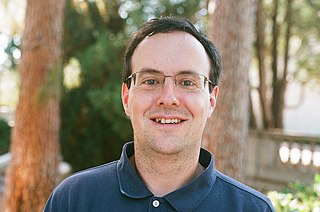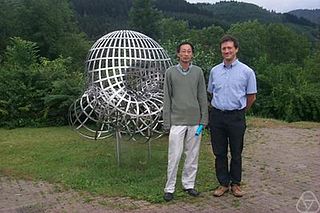L
- Lagrangian
- 3. Lagrangian fibration
- 4. Lagrangian intersection
- Liouville form
- The volume form on a symplectic manifold of dimension 2n.
This is a glossary of properties and concepts in symplectic geometry in mathematics. The terms listed here cover the occurrences of symplectic geometry both in topology as well as in algebraic geometry (over the complex numbers for definiteness). The glossary also includes notions from Hamiltonian geometry, Poisson geometry and geometric quantization.
In addition, this glossary also includes some concepts (e.g., virtual fundamental class) in intersection theory that appear in symplectic geometry as they do not naturally fit into other lists such as the glossary of algebraic geometry.
In differential geometry, a subject of mathematics, a symplectic manifold is a smooth manifold, , equipped with a closed nondegenerate differential 2-form , called the symplectic form. The study of symplectic manifolds is called symplectic geometry or symplectic topology. Symplectic manifolds arise naturally in abstract formulations of classical mechanics and analytical mechanics as the cotangent bundles of manifolds. For example, in the Hamiltonian formulation of classical mechanics, which provides one of the major motivations for the field, the set of all possible configurations of a system is modeled as a manifold, and this manifold's cotangent bundle describes the phase space of the system.
In mathematics, a symplectomorphism or symplectic map is an isomorphism in the category of symplectic manifolds. In classical mechanics, a symplectomorphism represents a transformation of phase space that is volume-preserving and preserves the symplectic structure of phase space, and is called a canonical transformation.
In differential geometry, a field in mathematics, a Poisson manifold is a smooth manifold endowed with a Poisson structure. The notion of Poisson manifold generalises that of symplectic manifold, which in turn generalises the phase space from Hamiltonian mechanics.
In mathematics, Nambu mechanics is a generalization of Hamiltonian mechanics involving multiple Hamiltonians. Recall that Hamiltonian mechanics is based upon the flows generated by a smooth Hamiltonian over a symplectic manifold. The flows are symplectomorphisms and hence obey Liouville's theorem. This was soon generalized to flows generated by a Hamiltonian over a Poisson manifold. In 1973, Yoichiro Nambu suggested a generalization involving Nambu–Poisson manifolds with more than one Hamiltonian.
In mathematical physics, geometric quantization is a mathematical approach to defining a quantum theory corresponding to a given classical theory. It attempts to carry out quantization, for which there is in general no exact recipe, in such a way that certain analogies between the classical theory and the quantum theory remain manifest. For example, the similarity between the Heisenberg equation in the Heisenberg picture of quantum mechanics and the Hamilton equation in classical physics should be built in.
Homological mirror symmetry is a mathematical conjecture made by Maxim Kontsevich. It seeks a systematic mathematical explanation for a phenomenon called mirror symmetry first observed by physicists studying string theory.
In mathematics, specifically in symplectic topology and algebraic geometry, Gromov–Witten (GW) invariants are rational numbers that, in certain situations, count pseudoholomorphic curves meeting prescribed conditions in a given symplectic manifold. The GW invariants may be packaged as a homology or cohomology class in an appropriate space, or as the deformed cup product of quantum cohomology. These invariants have been used to distinguish symplectic manifolds that were previously indistinguishable. They also play a crucial role in closed type IIA string theory. They are named after Mikhail Gromov and Edward Witten.
In mathematics, Floer homology is a tool for studying symplectic geometry and low-dimensional topology. Floer homology is a novel invariant that arises as an infinite-dimensional analogue of finite-dimensional Morse homology. Andreas Floer introduced the first version of Floer homology, now called symplectic Floer homology, in his proof of the Arnold conjecture in symplectic geometry. Floer also developed a closely related theory for Lagrangian submanifolds of a symplectic manifold. A third construction, also due to Floer, associates homology groups to closed three-dimensional manifolds using the Yang–Mills functional. These constructions and their descendants play a fundamental role in current investigations into the topology of symplectic and contact manifolds as well as (smooth) three- and four-dimensional manifolds.
The Geometry Festival is an annual mathematics conference held in the United States.
In symplectic topology, a Fukaya category of a symplectic manifold is a category whose objects are Lagrangian submanifolds of , and morphisms are Lagrangian Floer chain groups: . Its finer structure can be described as an A∞-category.

Richard Paul Winsley Thomas is a British mathematician working in several areas of geometry. He is a professor at Imperial College London. He studies moduli problems in algebraic geometry, and ‘mirror symmetry’—a phenomenon in pure mathematics predicted by string theory in theoretical physics.

Kenji Fukaya is a Japanese mathematician known for his work in symplectic geometry and Riemannian geometry. His many fundamental contributions to mathematics include the discovery of the Fukaya category. He is a permanent faculty member at the Simons Center for Geometry and Physics and a professor of mathematics at Stony Brook University.

Gabriele Vezzosi is an Italian mathematician, born in Florence, Italy. His main interest is algebraic geometry.
Kaoru Ono is a Japanese mathematician, specializing in symplectic geometry. He is a professor at the Research Institute for Mathematical Sciences (RIMS) at Kyoto University.
Ivan Smith is a British mathematician who deals with symplectic manifolds and their interaction with algebraic geometry, low-dimensional topology, and dynamics. He is a professor at the University of Cambridge.
Anton Yurevich Alekseev is a Russian mathematician.

Denis Auroux is a French mathematician working in geometry and topology.

Alberto Sergio Cattaneo is an Italian mathematician and mathematical physicist, specializing in geometry related to quantum field theory and string theory.
In mathematics, and especially symplectic geometry, the Thomas–Yau conjecture asks for the existence of a stability condition, similar to those which appear in algebraic geometry, which guarantees the existence of a solution to the special Lagrangian equation inside a Hamiltonian isotopy class of Lagrangian submanifolds. In particular the conjecture contains two difficulties: first it asks what a suitable stability condition might be, and secondly if one can prove stability of an isotopy class if and only if it contains a special Lagrangian representative.
The Arnold conjecture, named after mathematician Vladimir Arnold, is a mathematical conjecture in the field of symplectic geometry, a branch of differential geometry.